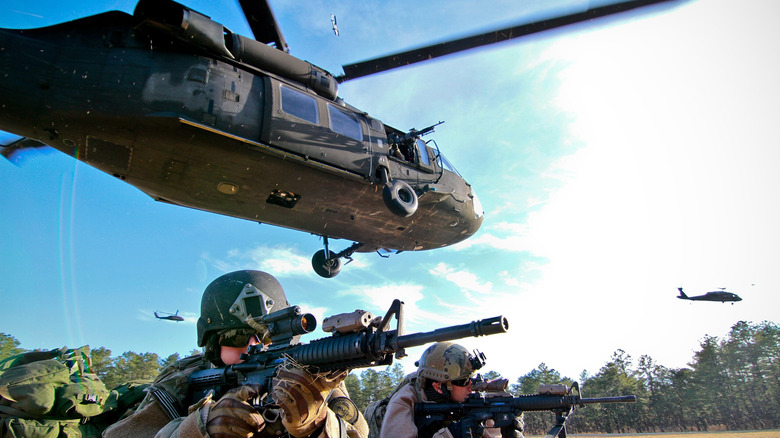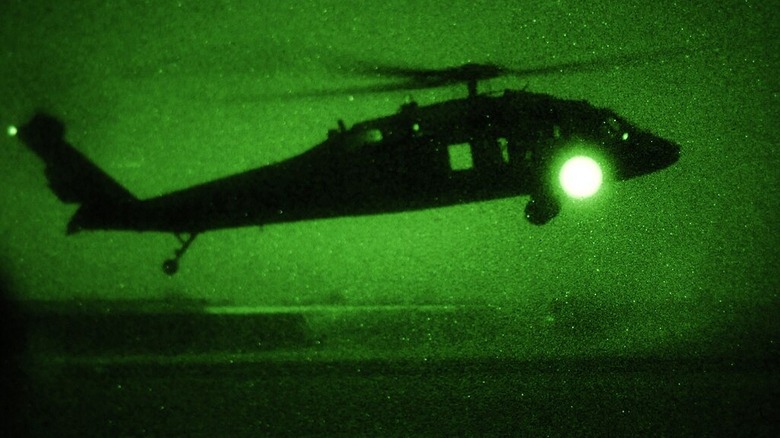Why Do Black Hawk Helicopters Keep Crashing?
The Sikorsky Black Hawk has been the Army's go-to helicopter since 1979. Considered a "utility tactical transport," they're sturdy, fast, and adaptable, capable of hauling heavy artillery as easily as troops. They're just as adept at providing medical evacuations as they are at conducting air assaults, fighting fires, and providing assistance during relief operations. The Army's reliance on this workhorse is so steadfast it plans to use it for another three decades. Despite the reliability, these helicopters have earned the nickname "Crash Hawk" due to several high-profile crashes.
Most people know this ubiquitous bird from the 2001 film "Black Hawk Down," based on the 1993 Battle of Mogadishu in Somalia, where three UH-60 Hawks were shot down. Helicopters are exponentially more dangerous than any fixed-wing aircraft because if the rotors fail, under most circumstances, the whole thing plummets to the ground. Black Hawks are more treacherous to fly than civilian helicopters because their design has inherent trade-offs that make them so incredibly special.
They're built with small rotors, considering their relative weight. While this gives them insane maneuverability, it also significantly reduces their aerodynamic safety margin. The slightest error or lapse in concentration during low-level maneuvering can have catastrophic consequences. Over 5,000 Black Hawks have been built since 1979 and account for 63% of the Army's total helicopter fleet. They've logged more than 15 million flight hours, including five million in direct combat, often hugging the ground to avoid radar (at night) and constantly exposed to hazards and small arms fire. They're one of the Army's most heavily used platforms and thus are put into dangerous situations at an exponentially higher rate.
There are far more Black Hawks in the air
Training for such constantly dangerous deployments (often at night) requires mandatory and equally hazardous scenarios to properly prepare. Unfortunately, that training resulted in several deaths. In January 2025, a Black Hawk helicopter collided with American Eagle Flight 5342 in Washington, DC, and killed 67 people, becoming the deadliest U.S. air crash in more than two decades. In 2023, two separate crashes (February and March) killed 11 soldiers during training, while one in 2021 resulted in three more deaths. In 2015, four Louisiana National Guardsmen and seven Marines died during a nighttime training exercise.
Going back to 1985, the Army grounded all Black Hawks after six crashes took place during a four-month period that resulted in 15 deaths. This was preceded by 22 additional deaths between 1981 and 1984. After the string of crashes in early 2023, including one involving two Apache helicopters (which are different from Black Hawks) that killed three soldiers, another aviation stand-down was ordered.
Congress investigated the accidents, many of which happened during National Guard operations, and found the blame fell on human error, poor training and safety precautions, lackadaisical maintenance, and simple overconfidence. However, data also showed something else rather interesting. Crashes involving Black Hawks accounted "for the fewest deadly incidents relative to hours flown," having a fatal incident rate of one per 100,000 hours flown. By comparison, the AH-64 Apache (which makes up 21% of the Army's fleet) had almost twice the fatal incidents at 1.93 per 100,000 flight hours, while the CH-47 Chinook's (at only 15% of the fleet) was 1.59.

